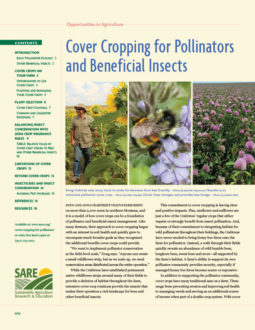Although cover crops can provide significant pollen and nectar resources for bees, they do have constraints. For example, because most cover crop species have a short bloom period, single species cover crops typically offer a feast-or-famine situation for bees. A shortage of food is followed by abundance, followed by another shortage. Under such circumstances wild pollinators may have trouble sustaining their populations. (Honey bees may be more resilient under such conditions due to their ability to store food reserves.)
Moreover, because most cover crop plants are nonnative species, their attractiveness to wild native bees may be highly variable. The cover crops highlighted in this bulletin will attract mostly generalist species of wild bees that are relatively common in most landscapes. Less common species of native bees often require more permanent plant communities comprised primarily of native plant species. In general, to maximize the diversity and abundance of beneficial wild insects, flowering cover crops should be combined with the restoration and maintenance of permanent, high-quality, pesticide-free native plant habitat in other areas of the farm. Adding pollinator hedgerows, establishing pollinator plantings on marginal lands and borders, and other practices to boost habitat can all fit into other USDA conservation practices.
Regarding pollinator borders specifically, two SARE funded research projects in Michigan demonstrated the value of permanent native wildflower strips adjacent to crops. In one of these studies [25], researchers found that corn borer egg parasitism was measurably higher in fields adjacent to perennial native wildflower strips. In the other study [26], researchers found that blueberries planted adjacent to perennial wildflower strips had berries that were 22-40 percent heavier, due to enhanced pollination by wild bees.
